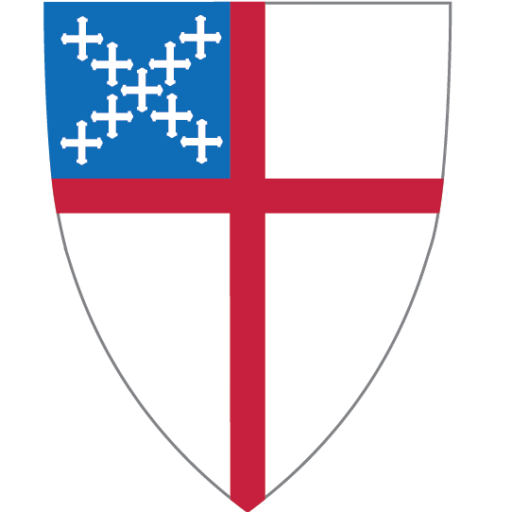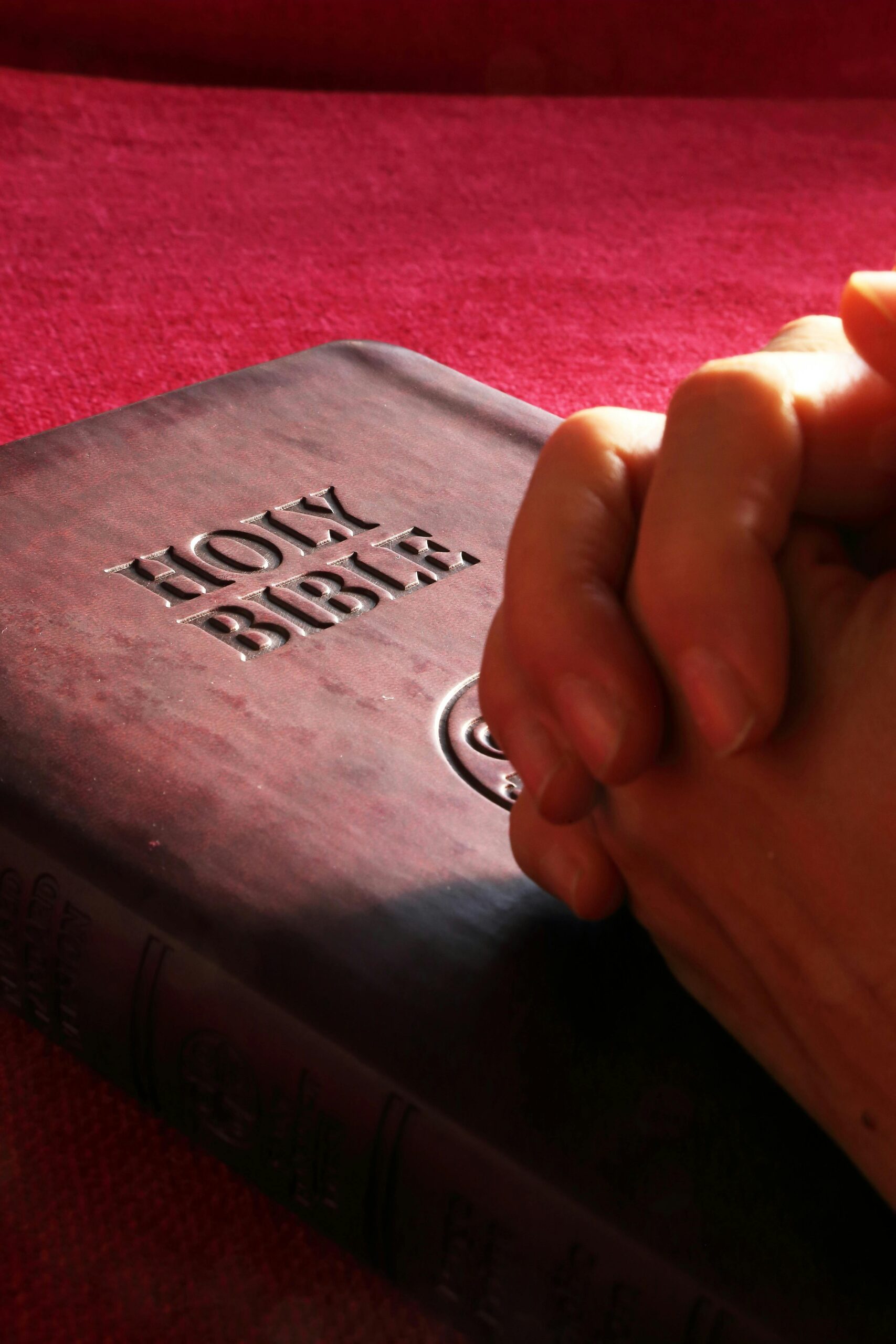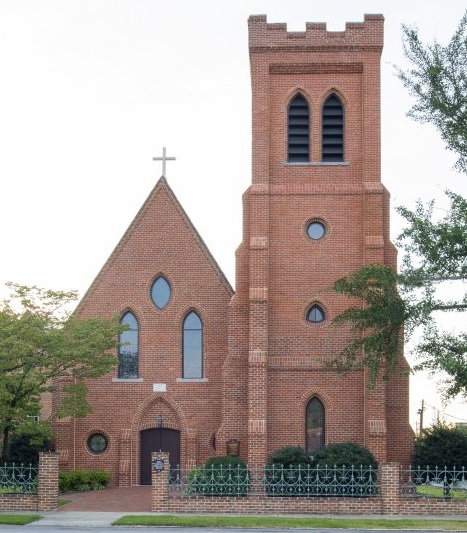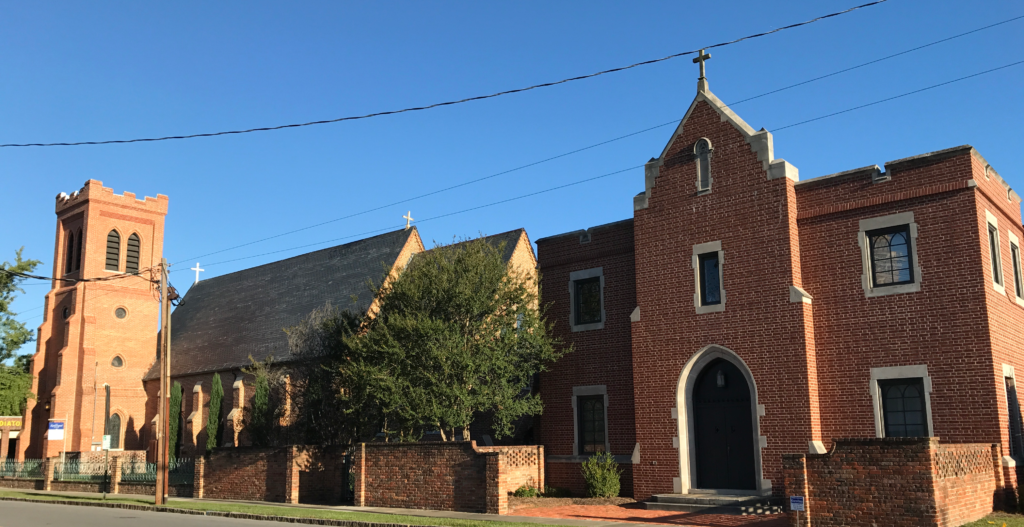On this page…
- What is an Episcopalian?
- The History of St. Stephen’s Episcopal Church
- How to Become a Member of St. Stephen’s Episcopal Church
What is an Episcopalian?
The Episcopal Church is:

Part of God’s One, Holy Church in the whole World!
The name of our church comes from the Greek word Episcopos which means “bishop” or “overseer.” The leaders of our church are called bishops, and we are called Episcopalians. All Episcopalians have bishops.
What do we believe?

Three important things show us the way to understand our God and our world.
The Bible – We believe that God and God’s people can speak to us through the Bible. All the things we need for a good life are in there.
Our Tradition – We are a church with many old stories. Some of these stories connect us to Jesus and the things he taught us. Some of the stories help us understand what other people think about God and Jesus.
Thinking – The Episcopal Church does not have a human-made set of rules for being God’s people. We believe that in our life with God we should use our minds—we should think about the Bible, tradition and our own experience.
The church is the people of God.
The church is not a building where people go to worship God. The church is all of God’s people. God’s people work in the world to help other people know about God’s love for all people. All of God’s people do God’s work. Some people are chosen to be leaders in the church. These people receive special training and education. They are “ordained.” This means they have been chosen by God and by the church to lead. They are called deacons, priests, and bishops. Other people do God’s work every day in everything they do. They are baptized. This means that they are part of God’s great family that we call the church.
Structure of the Episcopal Church
Many decisions in the Episcopal Church are made by a system of elections done by people elected to represent others. The leadership of the church is organized in a way that comes from our tradition. There is one bishop who is the leader of the whole Episcopal Church. This Presiding Bishop leads and serves the church. He does not command the church. There are bishops who lead the dioceses of the church. A “diocese” is a geographical area, like a state or a county. Each diocese has at least one bishop. A diocese has many member churches. They are called parishes or missions. The priest who leads a parish is called the rector; a priest who leads a mission is called the vicar. The council of people who make decisions for a parish is called the vestry. With the rector, these people take care of the business of the church. Each diocese has a convention that does the business of the diocese. The clergy and other elected church members make decisions at these conventions. Every three years, there is a national General Convention. At this convention, elected representatives from each diocese meet to make decisions for the whole of the Episcopal Church.
The Book of Common Prayer
The Book of Common Prayer belongs to everyone in the Episcopal Church. In this book you will find the words for the many different ways that Episcopalians worship God. Some of the worship services are used every day, like Morning Prayer and the Holy Eucharist. There are other worship services that are used for special times, like weddings and funerals. Also, you will find prayers written there. There is a prayer for almost any situation in the Book of Common Prayer. There is even a section of songs called Psalms. Psalms are songs used by God’s people for thousands of years to give God worship and praise. The Book of Common Prayer is at the center of the Episcopal Church as a church that worships God. You can find this book in any Episcopal Church, no matter where you go!
…from “Episcopalians”, adapted by Robert H. Grindrod from Episcopales, published by Forward Movement Publications. © Forward Movement Publications
This and many other publications can be ordered from the Forward Movement Publications site.
The History of St. Stephen’s Episcopal Church

The history of the Episcopal Church in Wayne County began in the early part of the 19th Century in the old town of Waynesborough, the former county seat near the Neuse River, and some four or five miles from Goldsboro. Here, at the suggestion of the two daughters of Richard Washington, and with the help of their friends George W. Collier and a Mr. Hobbs, and many other generous contributors of the community, a church was erected which was the common property of the various denominations of the County. The Rev. N. Collin Hughes, who was doing missionary duty in this and surrounding counties, officiated in this building for about two years. Except for these services, the only Episcopal services held in the town were those of occasional traveling clergymen, or of the Bishop at his annual visitation. Whatever of life and love for the church there was in Waynesborough was centered in the families of Mr. Richard Washington and Mrs. Eliza A. Churchill.
“There are only seven Professional Christians in Goldsboro. The preaching of the gospel is with no regularity and seems to produce no fruits. The towns with the exception noted were coldly and almost stupidly indifferent to the claims of religion. The Elders were engrossed in business and politics and the youngsters in pleasure.” Thus said the Rev. John Andrews in 1847.
In 1849 the “Great Revival” was held. Three weeks of preaching and prayer led to the profession of Faith by 100 souls and the formation of three of the main churches in Goldsboro: The First Presbyterian, St. Stephen’s Episcopal, and St. Paul Methodist.
An interesting fact of these first congregations is that the founding fathers were not necessarily members of the particular congregations they helped to found. Mr. E.B. Borden is a case in point. He is listed as one of the founders of St. Stephen’s, yet he was a member and founder of St. Paul Methodist Church. He also helped start the Presbyterian Church and the Jewish Synagogue. Such co-operation among denominations has marked relationships among our churches for their long history.
In 1848 Goldsboro became the County Seat, and Waynesborough, on account of being off the railroad, became a deserted village, whose inhabitants had moved to Goldsboro. The increased number of Episcopalians now demanded more ministrations of the church and the call of a clergyman to the growing missionary field. Accordingly in 1853, the Rev. A.F.N. Rolfe took charge, holding services in the new court house . He made earnest endeavors to collect funds for the erection of a church. The old church in Waynesborough was then moved to Goldsboro to form part of the material for the new building, but none of it was ever used except a small portion for a study, which was to be a nucleus for a rectory.
In December 1853, [a group of thirteen] gentlemen assembled for the purpose of organizing this Mission into a parish. …. The form of organization required by Canon VII of 1842 was subscribed to, and by the motion of Mr. G.V. Strong the name “St. Stephen’s Parish” was chosen. …
In 1854 the Rev. Mr. Rolfe moved to Goldsboro, and his salary was fixed at $300.00 a year. It was soon decided that a church must be built, so the vestry, after several meetings, voted to build one to cost $5,000. In January 1854, Mr. Rolfe was requested to leave the parish to obtain funds for the building of the church, but how long he was absent, or what funds he secured, is not mentioned in any parish record. In September 1854, the Rev. Mr. Rolfe resigned and moved to the Diocese of Maryland.
From September 1854 to July 1855, the Parish was without a rector or any regular services, at which time the Rev. Frederick Fitzgerald became the rector. He was to officiate three Sundays in each month and to receive a salary of $450.00 annually. The other Sunday in each month was given to St. Mary’s Parish, Kinston.
Mr. Fitzgerald, who was a remarkable man, undertook the project of building the church…. [He] secured the plan of an Early English Gothic Church, which was perfected by Mr. John W. Priest, an architect, of Newburgh, N.Y. During 1854 and 1855, the vestry acquired by purchase and gift a piece of land with a 170 ft. front on the West side of James Street. …
There was little money in the parish but the subscriptions were liberal, the leading spirits in the campaign being the rector and Mr. George W. Collier. Letters were sent to prominent clergy and laity throughout the country, since at this time there was no well-organized central method of church extension. The campaign inaugurated by Mr. Fitzgerald, asking everyone receiving an appeal to send one dollar, met with great success. While hundreds replied with this contribution, many sent sums from ten to one hundred dollars. Among the names of those subscribers, which are carefully preserved in Mr. Fitzgerald’s precise records, were several who became bishops: Cheshire, Coxe, Seymour, Clarkton, Bedell, Wilmer, Watson, and Littlejohn.
1856 was the year in which ground was broken for the church (August 8th) and the year for laying the cornerstone (August 27th). During construction, services were held in the court house three Sundays a month. The new Presbyterian Church was also utilized, witness Bishop Atkinson’s annual address in the Diocesan Journal, 1856: “May 11th, at Goldsborough, I preached morning and evening, administered the Holy Communion and confirmed five persons. These services were celebrated in a new church just erected by the Presbyterians, to whose kindness we were indebted. …”
The church building was finished in May, 1856. It is brick with granite sills, roof trusses of native heart pine, and without the tower cost $8,500.

The Rev. Mr. Fitzgerald read the first service in the church on Saturday night, May 2, 1857. A sermon was preached by the Right Reverend Thomas Atkinson, Bishop of the Diocese. The subject: “Eternal Punishment.”
The next day, a balmy May Sunday, was the third Sunday after Easter and despite unplastered walls, unfinished gallery and insufficient pews, the Holy Communion was celebrated preceded by Morning Prayer. Two women were also baptized and confirmed during the day.
Two years later, the first Diocesan Convention to be held in the parish commenced on Wednesday, May 4, 1859, adjourning Monday, May 9th. The Constitution and canons of the Church in the State of North Carolina were adopted. During the Convention on May 8th, the Church, having been finished and paid for, the consecration service took place. The Rev. Mr. Fitzgerald wrote in the parish register, “As is usual, the energy and devotion of the women of the parish aided greatly to the consummation of this work.”
–from Looking To The Future With Thanksgiving
For the Past, 1853-1983
St. Stephen’s has continued to worship in that original church for 157 years. Over that time, the parish and its parishioners have been involved in the formation of two mission parishes, St. George’s in Pikeville, founded between 1911-1915 (which folded in the 1960s) and St. Francis in Goldsboro, founded by 26 parishioners of St. Stephen’s in 1964, and first served by the then-assistant rector at St. Stephen’s. the Rev. James Wilson.
St. Stephen’s also has a long history of involvement in Goldsboro. Some ministries of particular interest/importance include:
- Ministry to airmen at Seymour-Johnson AFB during WWII, for which the rector received national recognition in The Living Church.
- Launching the Hospital Auxiliary at Wayne Memorial Hospital.
- Beginning a sheltered workshop in 1966 – people of different abilities initially worked in
St. Stephen’s Parish Hall removing labels from uniforms. - Helping with the establishment of a cottage in Goldsboro for Thompson Orphanage (now Thompson Child and Family Focus). St. Stephen’s was very involved in the religious education of children living there, and parishioners faithfully brought gifts and birthday cakes to them.
- Geriatric Program with Cherry Hospital, a psychiatric hospital in Goldsboro – parishioners first went to the wards at the hospital to play games and share music and dancing; residents were later brought to St. Stephen’s for activities.
- The Community Soup Kitchen (originally St. Stephen’s Soup Kitchen, operating from the Church for more than 24 years before relocating to the nearby Congregation Oheb Sholom, which was no longer used for worship). Starting with a pot of soup and one canned ham in December 1981, the Kitchen served more than 39,000 meals in 2013. Parishioners continue to volunteer at the Kitchen, and several currently serve on its board.
- Partnership with Dillard Middle School. Since 2011 parishioners have tutored Dillard students, and donations are regularly collected to meet needs of the teachers (hand sanitizers, tissues, etc.) and very basic needs of the students (toothbrushes and toothpaste, deodorant, and new underwear).
How to become a member of St. Stephen’s Episcopal Church
First of all, we would love to have you join St. Stephen’s Episcopal Church! Please contact the Rev. David Wyly (Rector) or Vicky Bailey (Parish Administrative Assistant) and they will be happy to help you. Here is some general information about membership in the Church.
Baptism makes us members of the Church. And, we can then live into the meaning of our baptism within specific congregations and Christian denominations. The five sections below will spell this out more fully.
1. Most importantly, the sacrament of Holy Baptism, makes you a member of the Universal Christian Church. The Episcopal Church recognizes as Christian all persons who have been baptized with water and in the name of the Holy Trinity (Father, Son, Holy Spirit).
2. If you were baptized into the Universal Church in an Episcopal congregation then, in addition to becoming a member of the Universal Church, you were enrolled as a member of that particular congregation and also became an “Episcopalian.” You are member at the church where you were baptized until death or until you transfer to another congregation. So, if you were baptized at St. Stephen’s, you are a baptized member here. If you have asked that the record of your baptism be transferred here, then you are a member here as well.
3. If you were baptized with water and in the name of the Trinity in another Christian communion or denomination, you can become a member of St. Stephen’s by asking that your letter of baptism be transferred so that you can be enrolled on the books of this parish. This makes you a baptized member of the Episcopal Church in general and a member of St. Stephen’s specifically.
4. All baptized members are encouraged to receive the sacrament of confirmation, either when they reach maturity or in connection with baptism if they are baptized as adults. In confirmation ‘we express a mature commitment to Christ and receive strength from the Holy Spirit through prayer and the laying on of hands by a bishop.’ After confirmation, a person is a confirmed member.
5. If you were baptized and confirmed in another church you may be received (rather than reconfirmed) by a bishop of The Episcopal Church. This makes you a confirmed member of The Episcopal Church. Adult (16 years of age and older), confirmed, communicants in good standing (you have been faithful in attending corporate worship and in praying, working, and giving for the spread of the Kingdom of God) may vote for Vestry (the ruling body of the congregation), run for the Vestry and represent the congregation in the diocese.
6. While not a requisite for membership we encourage all members of St. Stephen’s to prayerfully consider a yearly financial commitment to the church.
We hope this answers some of your questions. And we encourage you to be in touch. You are most welcome at St. Stephen’s Episcopal Church!
(Much of the information above was taken from the Forward Movement brochure on “Membership in the Episcopal Church”. Forward Movement is an official, non-profit agency of The Episcopal Church and is sustained through sales of tracts and through tax-free contributions. They can be reached at 300 West Fourth Street, Cinicinnati, OH 45202-2666, 800-543-1813; www.forwardmovement.org)
